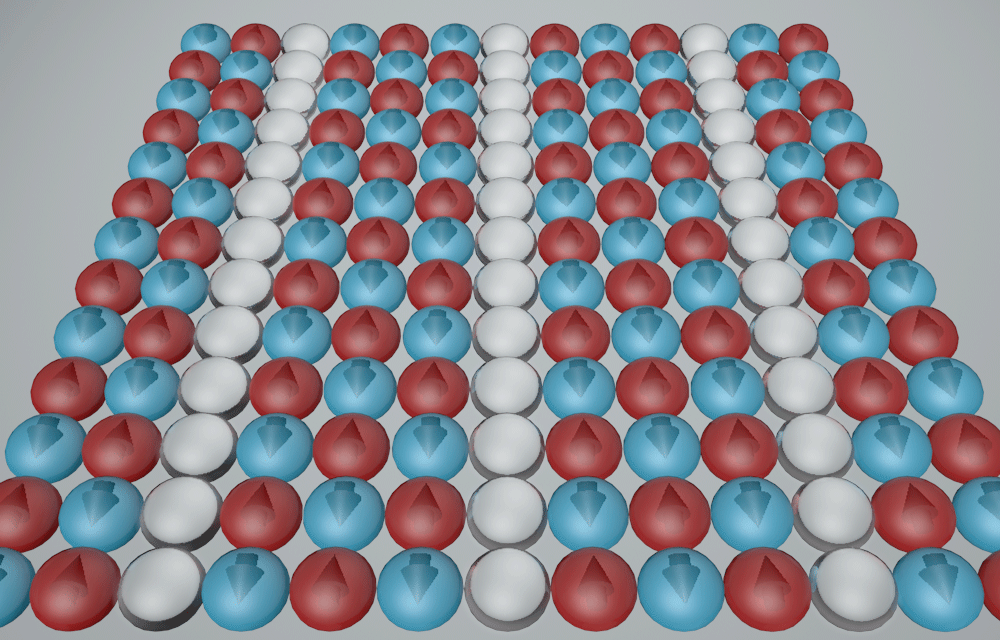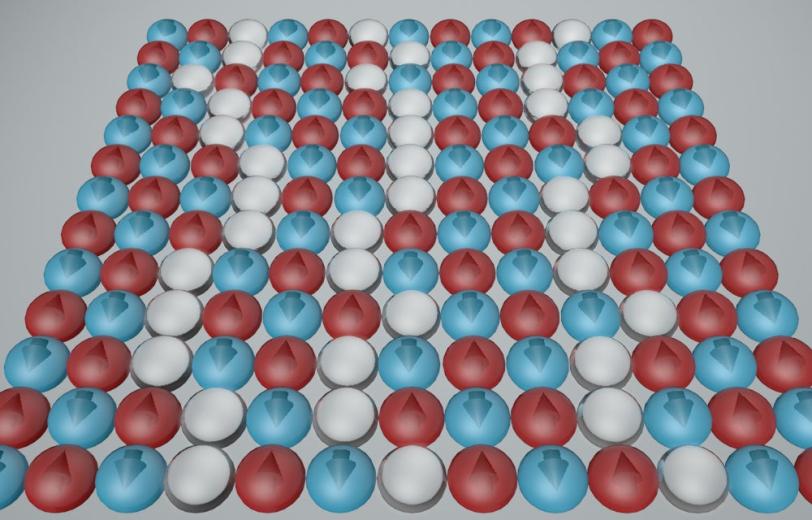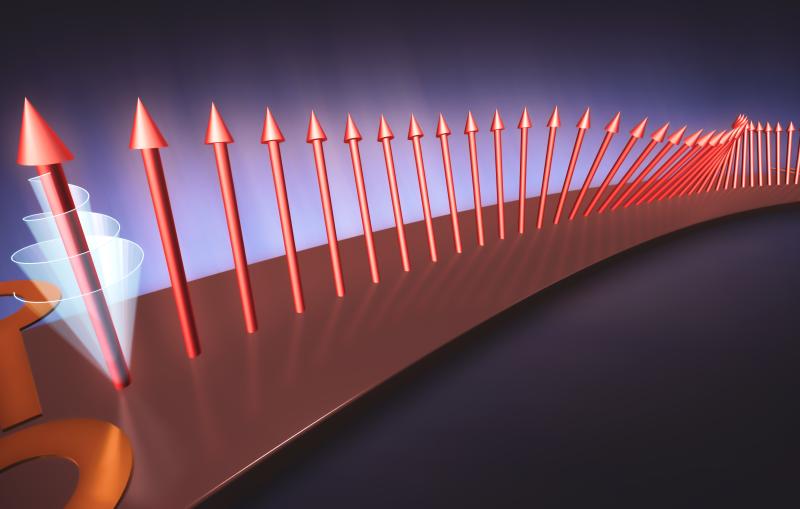Study Confirms that Cuprate Materials Have Fluctuating Stripes that May Be Linked to High-temperature Superconductivity
These stripes of electron spin and charge are exciting because of their possible link to a phenomenon that could transform society by making electrical transmission nearly 100 percent efficient.
By Glennda Chui
Scientists at the Department of Energy’s SLAC National Accelerator Laboratory and Stanford University have shown that copper-based superconductors, or cuprates – the first class of materials found to carry electricity with no loss at relatively high temperatures – contain fluctuating stripes of electron charge and spin that meander like rivulets over rough ground.
The stripes are zones where electrons either pile up, creating bands of negative charge, or align their spins to create bands of magnetism. They were previously known to exist in cuprate superconductors at temperatures near absolute zero, although in this deep chill the stripes did not move around and their exact role in superconductivity – do they boost or squelch it? – has been unclear.
Now the researchers have computationally demonstrated for the first time that these stripes also exist at high temperatures, but they are subtle and fluctuate in a way that could only be discovered through numerical computer simulations of a precision and scale not done before. The scientists described their study in Science today.

“There’s reason to think that stripes of charge and spin may be intimately tied to the emergence of high-temperature superconductivity in these materials, which was discovered 30 years ago but so far is not understood or explained,” said Edwin Huang, a physics graduate student at Stanford and at the Stanford Institute for Materials and Energy Sciences (SIMES) at SLAC.
“This discovery of fluctuating stripes in a realistic computer model will give us a way to test the many theories about how stripes are related to superconductivity,” Huang said. “We think our results will be useful for scientists doing experimental studies of these materials, and they’ll also help develop and refine the computational techniques that go hand in hand with theory and experiments to push the field forward.”
The results also apply to other novel materials, said SIMES Director Thomas Devereaux. “Materials that spontaneously develop this sort of non-uniform structure are quite commonplace, including magnets and ferroelectrics,” he said. “It can even be thought of as a signature of ‘quantum’ materials, whose surprising properties are produced by electrons that cooperate in unexpected ways. Our numerical results demonstrate that this phenomenon can generally be related to strong interactions between electron charges and spin.”
A Mysterious Phenomenon
In conventional electrical conductors, current is transmitted by electrons acting individually. But in superconductors, electrons pair up to transmit current with virtually no loss.
For 75 years after their discovery, all known superconductors operated only at temperatures close to absolute zero, limiting the way they could be used.
That changed in 1986, when scientists discovered that cuprates could superconduct at much higher (although still quite chilly) temperatures. In fact, certain cuprate compounds are superconducting at temperatures higher than 100 kelvins, or minus 173 degrees Celsius, allowing development of superconducting technologies that can be chilled with liquid nitrogen.
But researchers are still far from their goal of finding superconductors that operate at close to room temperature for highly efficient power lines, maglev trains and other applications that could have a profound impact on society. Without a fundamental understanding of how high-temperature superconductors work, progress has been slow.
Computer modeling is a critical tool for achieving that understanding. Models are sets of mathematical equations based on physics that theorists create and continually refine to simulate a material’s behavior using computer algorithms. They check their models against observations and experimental results to make sure they’re on the right track.
In this case, the team modeled electron behavior and interactions in one of a cuprate’s copper oxide layers, which is where the interesting physics happens, said SIMES staff scientist Brian Moritz. The calculations were run on Stanford’s Sherlock supercomputer cluster at SLAC and at the DOE’s National Energy Research Scientific Computing Center in Berkeley.
The results were in good agreement with data from neutron scattering experiments on a variety of cuprates, the scientists said, confirming that their simulations accurately capture the electronic physics of these materials.
A More Accurate Model
This is the first time the high-temperature behavior of cuprates has been simulated with a realistic model that covers a large enough area of the material to see fluctuating stripes, Huang said. This larger scale also makes the calculations more accurate.
“There was a fine balance we needed to strike,” he said. “These are extremely computationally demanding calculations. But if you simulate the behavior of smaller areas, you won’t be able to see any stripes that emerge. That was the primary limitation of previous studies.”
The simulations show that stripes emerge at temperatures up to 600 degrees Celsius and in a wide range of doping conditions, where compounds are added to a material to tweak its electronic behavior, and so they appear to be a universal trait of cuprate superconductors, the researchers said.
“The idea that there are fluctuating stripes in cuprates is not new, but it has been a controversial topic for many years,” Huang said. “What’s new here is that we can support their existence using unbiased computation on a realistic model of these materials.”
One thing the study does not do, he added, is answer the question of whether or how the fluctuating stripes figure into superconductivity: “That is the direction we want to head toward.”
In addition to SLAC and Stanford, contributors to this study came from the University of Tennessee, Knoxville and its Joint Institute for Advanced Materials. The research was funded by the DOE Office of Science.
Citation: E. Huang et al., Science, 1 December 2017 (10.1126/science.aak9546)
Contact
For questions or comments, contact the SLAC Office of Communications at communications@slac.stanford.edu.

About SLAC
SLAC National Accelerator Laboratory explores how the universe works at the biggest, smallest and fastest scales and invents powerful tools used by researchers around the globe. As world leaders in ultrafast science and bold explorers of the physics of the universe, we forge new ground in understanding our origins and building a healthier and more sustainable future. Our discovery and innovation help develop new materials and chemical processes and open unprecedented views of the cosmos and life’s most delicate machinery. Building on more than 60 years of visionary research, we help shape the future by advancing areas such as quantum technology, scientific computing and the development of next-generation accelerators.
SLAC is operated by Stanford University for the U.S. Department of Energy’s Office of Science. The Office of Science is the single largest supporter of basic research in the physical sciences in the United States and is working to address some of the most pressing challenges of our time.





